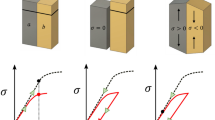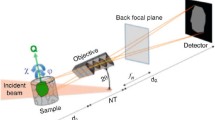Abstract
A description is presented of some basic configurations and properties of defects in crystalline solids. The current theoretical and empirical descriptions of deformation are reviewed in relation to these defects (or imperfections), which may be planar, linear or confined to only one lattice point.
The techniques of electron microscopy and X-ray diffraction used in the examination of defects are briefly summarized. Planar defects can generally be detected by optical techniques, which, under certain conditions, may also reveal dislocations. Individual dislocations, their movement and interaction can, however, be observed most clearly by thin-film electron-transmission techniques. The direct observation of vacancies has been possible in only a restricted number of cases by using field-ion emission. X-ray diffraction has proved useful in obtaining information about both planar and line defects (i.e., stacking faults and dislocations).
The stress-strain curve of both single- and polycrystalline materials can be understood and described reasonably well in terms of the type, density and distribution of dislocations, determined by the use of the various techniques for observing them. Details are given in the paper. Knowledge of the microstructure at the atomic level is of great value in assessing past histories and possible future behavior of crystalline materials.
Similar content being viewed by others
References
Friedel, J., “Dislocations,”Addison-Wesley (Pergamon Press) London (1964).
Jasperse, J. R., andDoherty, P. E., “Nucleation of Surface Pits by the Condensation of Vacancies,”Phil. Mag.,9,635–644 (1964).
Brandon, D. G., Ralph, B., Ranganathan, S., andWald, M. S., “A Field Ion Microscope Study of Atomic Configuration at Grain Boundaries,”Acta Met.,12,813–823 (1964).
Hren, J. J., “An Analysis of the Atomic Configuration of an Incoherent Twin Boundary with the Field Ion Microscope,”Acta Met.,13,479–485 (1965).
Amelinckx, S., “The Direct Observation of Dislocations,”Academic Press, N. Y. (1964).
Otte, H. M., andWelch, D. O., “Formation of Stacking Faults in Polycrystalline Silicon Bronze Under Tensile Deformation,”Phil. Mag.,9,299–313 (1964).
Hirsch, P. B., “Dislocation Distributions and Hardening Mechanisms in Metals,” Conf. on the Relation between Structure and Mechanical Properties of Metals, NPL, Teddington (H.S.O., London), 40–82 (1963).
Mikkola, D. E., and Cohen, J. B., “Examples of Applications of Line Broadening,” Local Atomic Arrangements Studied by X-Ray Diffraction, ed. J. B. Cohen and J. E. Hilliard, AIME, 1965 (in press), Gordon and Breach (also ONR contract NONR 1228 (20), TR No. 4, June 1, 1965).
Weissmann, S., andWriedt, D. F., “On Guinier-Preston Zones in an Aluminum-Silver Alloys,”Acta Met.,12,276–277 (1964).
Seeger, A., discussion Conf. on the Relation between Structure and Mechanical Properties, NPL, Teddington (H.S.O., London), 127 (1963).
Cottrell, A. H. “The Mechanical Properties of Matter,”John Wilay, N. Y. (1964).
Votava, E., andSleesuyk, A. W., “Emissary Dislocations in a Molybdenum-Rhenium Alloy,”Acta. Met.,10,965–970 (1962);R. Priestner, “On Emissary Dislocations,” Acta Met.,13,564–566 (1962); Sleeswyk, A. W., and Terasaki, F., “Reply to ‘On Emissary Dislocations’”, Acta Met.,13,566–568 (1965).
Gilman, J. J., andJohnston, W. G., “Behavior of Individual Dislocations in Strain-Hardened LiF Crystals,”Jnl. Appl. Phys.,31,687–692 (1965).
Chen, W. S., Gilman, J. J., andHead, A. K., “Dislocation Multipoles and Their Role in Strain Hardening,”Jnl. Appl. Phys.,35,2506–2514 (1964).
Kuhlmann-Wilsdorf, D., andWilsdorf, H. G. F., “Origin of Dislocation Tangles and Loops in Deformed Crystals,” “Electron Microscopy and Strength of Crystals,”Interscience, N. Y., 575–604 (1963).
Seeger, A., “Work-Hardening of Metal Single Crystals, Slip Lines, and Transmission Electron Microscopy,” Conf. on the Relation between Structure and Mechanical Properties of Metals, NPL, Teddington (H.S.O., London), 4–38 (1963).
Thomas, G., “Dislocations—Their Origin and Multiplication,”Jnl. Metals,16,365–369 (1964).
Gilman, J. J., “Mechanical Behavior of Ionic Crystals,”Prog. Ceramic Sci.,1,146–199 (1961).
Embury, J. D., andNicholson, R. B., “Dislocation Sources in an Aluminum Alloy,”Acta Met.,11,347–355 (1963).
Thomas, G., andWashburn, J., “Precipitation of Vacancies in Metals,”Ruw. Mod. Phys.,35,992–1011 (1963).
Reed-Hill, R. E., “Physical Metallurgy Principles,”D. van Nostrand Co., Inc., Princeton, N. J. (1964).
Thomas, G., “Transmission Electron Microscopy of Metals,”J. Wiley and Sons, N. Y. (1962).
Hirsch, P. B., Howie, A., andWhelan, M. J., “A Kinematical Theory of Diffraction Contrast of Electron Transmission Microscopy Images of Dislocations and Other Defects,”Phil. Trans.,A252,499–529 (1960).
Whelan, M. J., andHirsch, P. B., “Electron Diffraction from Crystals Containing Stacking Faults: I and II,”Phil. Mag.,2,1121–1142 and 1303–1324 (1957).
Howie, A., andWhelan, M. J., “Diffraction Contrast of Electron Microscope Images of Crystal Lattice Defects. II. The Development of a Dynamical Theory,”Proc. Roy. Soc.,A263,217–237 (1961); “Diffraction Contrast of Electron Microscope Images of Crystal Lattice Defects. III. Results and Experimental Confirmation of the Dynamical theory of Dislocation Image Contrasts,” Proc. Roy. Soc.,A267,206–230 (1962).
Brown, L. M., “Application of Thin Foil Electron Microscopy to Metallurgical Problems,” “From Molecule to Cell: Symposium on Electron Microscopy,”ed. P. Buffa, Consiglio Nazionale Delle Richerche, Rome, Italy, 99–118 (1964).
deWit, R., “Displacement of Dislocation Images formed in Transmission Electron Microscopy,”Jnl. Appl. Phys.,36,329–330 (1965).
Hashimoto, H., Howie, A., andWhelan, M. J., “Anomalous Electron Absorption Effects in Metal Foils: Theory and Comparison with Experiment,”Proc. Roy. Soc.,A269,213–238 (1962).
Bailey, J. E., andHirsch, P. B., “The Dislocation Distribution Flow Stress, and Stored Energy in Cold-worked Polycrystalline Silver,”Phil. Mag.,5,485–497 (1960).
Keh, A. S., “Dislocation Arrangement in Alpha Iron during Deformation and Recovery,”Direct Observation of Imperfections in Crystals,”Interscience, N. Y. 213–238 (1962).
Ham, R. K., “The Determination of Dislocation Densities in Thin Films,”Phil. Mag.,6,1183–1184 (1961).
Ham, R. K., andWright, M. G., “The Effect of Thickness on the Distribution of Dislocations in Cold-rolled Aluminum,”Phil. Mag.,10,937–948 (1964).
Valdre, V., andHirsch, P. B., “Rearrangements of Dislocations in Stainless Steel during Electropolishing,”Phil. Mag.,8,237–246 (1963).
Grosskreutz, J. C., andShaw, C. G., “Dislocation Rearrangement in Fatigue-hardened Aluminum during Preparation for Transmission Electron Microscopy,”Phil. Mag.,10,961–968 (1964).
Weissman, S., “Investigation of Crystalline Imperfections and Properties of Materials,”Am. Sci. (Sigma Xi),51,193–226 (1963).
Barrett, C. S., “A New Microscopy and Its Potentials,”AIME,161,15–64 (1945).
Lang, A. R., “Direct Observation of Individual Dislocations by X-ray Diffraction,”Jnl. Appl. Phys.,29,597–98 (1958);“Studies of Individual Dislocations in Crystals by X-ray Diffraction,” Jnl. Appl. Phys.,30,1748–1755 (1959).
Gay, P., Hirsch, P. B., andKelly, A., “The Estimation of Dislocation Densities in Metals from X-ray Data,”Acta Met.,1,315–319 (1953);“X-ray Studies of Poycrystalline Metals Deformed by Rolling: Part II The Physical Interpretation of the Experimental Results,” Acta Cryst.,7,41–49 (1954).
Wagner, C. N. J., “Analysis of the Broadening and Changes in Position of X-ray Powder Pattern Peaks,” “Local Atomic Arrangements Studies by X-ray Diffraction,” ed. J. B. Cohen and J. E. Hilliard, AIME, 1965 (in press), Gordon & Breach.
Wagner, C. N. J., Tetelman, A. S., andOtte, H. M., “Diffraction from Layer Faults in bcc and fcc Structures,”Jnl. Appl. Phys.,33,3080–3086 (1962).
Warren, B. E., “X-ray Studies of Deformed Metals,”Prog. Met. Phys.,8,147–202 (1958).
Williamson, G. K., andSmallman, R. E., “Dislocation Densities in Some Annealed and Cold-worked Metals from Measurements on the X-ray Debye-Scherrer Spectrum,”Phil. Mag.,1,34–46 (1956).
Taylor, G. I., “The Mechanism of Plastic Deformation of Crystals: Part I Theoretical, Part II Comparison with Observations,” Proc. Roy. Soc.,A145,362–387 (Pt. I); 388–404 (Pt. II) [“The Scientific Papers of Sir Geoffrey Ingram Taylor,” ed. G.K. Batchelor, Cambridge University Press, N. Y.,1,Nos. 21 and 22 (1958)].
van Torne, L. I., andThomas, G., “Yielding and Plastic Flow in Niobium,”Acta Met.,11,881–899 (1963).
Hull, D., McIvor, I. D., and Owen, W. S., “The Variation of Flow Stress with Substructure in Tantalum,” Conf. on the Relation between Structure and Mechanical Properties of Metals, NPL, Teddington (H.S.O., London), 596–612 (1963).
Cottrell, A. H., “Dislocations and Plastic Flow in Crystals,”Oxford University Press, Oxford (1953).
Cottrell, A. H., “Theory of Brittle Fracture in Steel and Similar Metals,”AIME,212,192–203 (1958).
Cottrell, A. H., “Discontinuous Yielding,” Conf. on the Relation between Structure and Mechanical Properties of Metals, NPL, Teddington (H.S.O., London), 456–473 (1963).
Suzuki, H., “A Note on the Yield Points of Polycrystalline Metals and Alloys,” Conf. on the Relations between Structure and Mechanical Properties of Metals, NPL, Teddington (H.S.O., London), 518 (1963).
Bell, J. F., “Single, Temperature-Dependent Stress-Strain Law for the Dynamic Plastic Deformation of Annealed Face-Centered Cubic Metals,”Jnl. Appl. Phys.,34,134–141 (1963).
Hahn, G. T., Gibert, A., andReid, C. N., “Dislocation Dynamics of Yielding,”Battelle Technical Rvw.,12,3–8 (1963).
Johnston, W. G., “Yield Points and Delay Times in Single Crystals,”Jnl. Appl. Phys.,33,2716–2730 (1962).
Jaffee, R. I., and Hahn, G. T., “Structural Considerations in Developing Group VI-A Alloys,” Conf. on the Relations between Structure and Mechanical and Properties of Metals, NPL, Teddington (H.S.O., London), 708–736 (1963).
Johnston, W. G., andGilman, J. J., “Dislocation Velocities, Dislocation Densities, and Plastic Flow in Lithium Fluoride Crystals,”Jnl. Appl. Phys.,30,128–144 (1959).
Boček, M.,“Zusammenfassende Darstellung der Gleitverformung in Metallen mit dichtest gepackter Struktur,” “Collected Review of the Glide Deformation of Metals with the Close Packed Structure,” Phys. Stat. Sol.,3,2169–2214 (1963).
Mitchell, T. E., andFoxall, R. A., andHirsch, P. B., “Work Hardening in Niobium Single Crystals,”Phil. Mag.,8,1895–1920 (1963).
Smallman, R. W., “Modern Physical Metallurgy,”Butterworths, London (1963).
Seeger, A., Mader, S., andKronmuller, H., “Theory of Work Hardening of Face Centered Cubic and Hexagonal Close Packed Single Crystals,”Electron Microscopy and Strength of Crystals,”Interscience, N. Y., 665–712 (1963).
Matt, N. F., “The Work Hardening of Metals,”AIME,218,962–968 (1960).
Levinstein, H. J., and Robinson, W. H., “Dislocation Configurations in Deformed Silver Single Crystals,” Conf. on the Relation between Structure and Mechanical Properties of Metals, NPL, Teddington (H.S.O., London), 180–203 (1963).
Wiedersich, H., “Hardening Mechanisms and the Theory of Deformation,”Jnl. Metals,16,425–430 (1964).
Seeger, A., “The Mechanism of Glide and Work Hardening in Face Centered Cubic and Hexagonal Close Packed Metals,”Dislocation and Mechanical Properties of Crystals,”Wiley and Sons, N. Y.,243–329 (1957).
Basinski, Z. S., “Thermally Activated Glide in Face-Centered Cubic Metals and Its Application to the Theory of Strain Hardening,”Phil. Mag.,4,393–432 (1959).
Kuhlmann-Wilsdorf, D., “A New Theory of Work Hardening,”AIME, 224, 1047–1061 (1962).
Nabarro, F. R. N., Basinski, Z. S., andHolt, D. B., “The Plasticity of Pure Single Crystals,”Advances in Phys. (Phil. Mag. Suppl.),13,193–323 (1964).
Seeger, A., Berner, R., andWolf, H., “Die Experimentalle Bestimmung von Stapelfehlerenergien Kubisch-flachenzentrienter Metalle,” “The Experimental Determination of Stacking Fault Energies in Face Centered Cubic Metals,”J. Z. Phys.,155,247–262 (1959).
Bell, J. F., “A Generalized Large Deformation Behavior for Facecentered Cubic Solids—High Purity Copper,”Phil. Mag.,10,107–26 (1964).
Bell, J. F., “Experimental Study of the Interrelation between the Theory of Dislocations in Polycrystalline Media and Finite Amplitude Wave Propagation in Solids, Jnl. Appl. Phys.,32,1982–1993 (1961).
Bailey, J. E., quoted by Reference 70.
Livingston, J. D., “The Density and Distribution of Dislocations in Deformed Copper Crystals,”Acta Met.,10,229–240 (1962).
Venables, J. A., “Dislocation Distributions and Densities in F. C. C. Copper Alloy,”Phil. Mag.,7,1969–1972 (1962).
Mader, S., Seeger, A., andThieringer, H., “Work Hardening and Dislocation Arrangement for fcc Single Crystals. II. Electron Microscope Transmission Studies of Ni-Co Single Crystals and Relation to Work Hardening Theory,”Jnl. Appl. Phys. 34,3376–3386 (1963).
Keh, A. S., andWeissmann, S., “Deformation Substructure in Body Centered Cubic Metals,” “Electron Microscopy and Strength of Crystals,”Interscience, N. Y., 231–300 (1963).
Keh, A. S., “Work Hardening and Deformation Sub-Structure in Iron Single Crystals Deformed in Tension at 298° K,”Phil. Mag.,12,9–30 (1965).
Lawley, A., andGallagher, H. L., “Deformation Structures in Zonemelted Molybdenum,”Phil. Mag.,10,15–23 (1964).
Edington, J. W., andSmallman, R. E., “The Relationship Between Flow Stress and Dislocation Density in Deformed Vanadium,”Acta Met.,12,1313–1328 (1964).
W. in der Schmitten andHaasen, P., “Dislocation Density and Flow Stress of Sodium Chloride,”Jnl. Appl. Phys.,32,1790–1791 (1961).
Taylor, G. I., “Plastic Strain in Metals,”Jnl. Inst. Metals,62,307–324 (1938). [“The Scientific Papers of Sir Geoffrey Ingram Taylor,” ed. G. K. Batchelor, Cambridge University Press, N. Y.,1 (27), (1958)].
Crocker, A. G., “Defects in Crystalline Solids and Their Relation to Mechanical Properties,”Experimental Mechanics,6 (5), 266–272 (1966).
Dorn, J. E., Mitchell, J., andHauser, F., “Dislocation Dynamics,”Experimental Mechanics,5 (11),353–362 (1965).
Hirsch, P. B., “A Theory of Linear Strain Hardening in Crystals,”Discussions Faraday Soc.,38,111–122 (1964).
Author information
Authors and Affiliations
Additional information
Paper is devoted to plastic behavior of materials and is largely concerned with crystal defects
Rights and permissions
About this article
Cite this article
Otte, H.M., Hren, J.J. The observation of crystalline imperfections and their role in plastic deformation. Experimental Mechanics 6, 177–193 (1966). https://doi.org/10.1007/BF02326148
Issue Date:
DOI: https://doi.org/10.1007/BF02326148




